Dee Estuary Birding
Monthly Newsletter...
January 2024 Newsletter
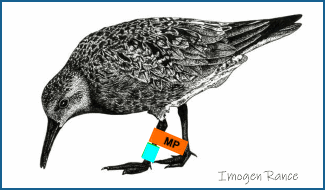
Exceptional Numbers!
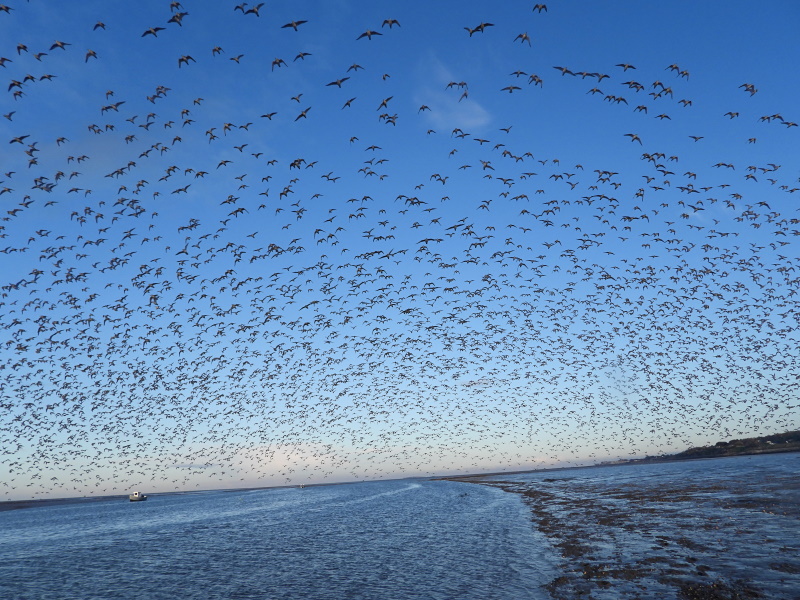

In many ways 2023 was a pretty horrible year, what
with Global Warming,
Bird Flu (HPAI) and Insect Armageddon -
to name just three major environmental issues - then there were two
nasty wars, huge increases in the cost of living........ So I thought
I'd
try and
cheer us all
up by remembering some good times when exceptional numbers of birds
have been present on the Dee Estuary and the Wirral coast. But it's not
just about remembering the past, it's also about anticipating the
future as many of these exceptional numbers could be repeated, indeed
two of
these events have taken place in the past two years.
I've chosen nine species* when exceptional numbers have been present here, and I have only chosen those which have been exceptional in a national context, not just local. I hope you enjoy reading about them.
* Three of those species are lumped together in one
section under 'Terns' - Sandwich, Arctic and Common.
Common Scoters
It was October 21st 2016 and one of those lovely
autumn days when the sea was like a mirror - and covered in Common
Scoters. 40,000 of them! These were counted from Hoylake when the birds
were off East Hoyle Bank with ideal conditions - no wind and excellent
visibility. The video below, by Jane Turner, gives an idea of what it
was like that day.
Video shows about half of the vast numbers of Common Scoters off
Hoylake on October 21st 2016 - video by Jane Turner.
As far as I know that remains the highest ever number of Common Scoters counted in the UK from a single site. But perhaps the most surprising thing about that count is that it wasn't actually a huge surprise as we'd been seeing really big numbers since the winter of 2013/14. The first five-figure count of Scoter ever made off the Dee Estuary in January 2014 with 12,000, followed by a whopping 27,000 counted from Hilbre in March that same year. We then had at least 22,500 in March 2015 and 36,000 in February 2016 before that 40,000 count in October.
But we've not finished with exceptional numbers of Scoters yet. It wasn't until aerial surveys carried out between 2004/05 and 2010/11 that it was realised just how important Liverpool Bay was for them, and the mean peak over those five years for the whole of Liverpool Bay was found to be 57,995 - compared to previous estimates of no more than 10,000. Because of those numbers, plus a large gathering of Red-throated Divers, Liverpool Bay was made into a Special Protection Area (see Liverpool Bay SPA). But more recent aerial surveys using better cameras and some clever bird identification software have come up with a massive 160,000 Common Scoters in Liverpool Bay! (as per The Birds of Wales, 2021).
Great Crested Grebes
In the winter of 2005/06 the Dee Estuary was
something like the 100th most important site for Great Crested Grebes
in the country with a max count of 33, not a very impressive statistic
for one of the foremost wetland sites in the country. But the following
winter it was the eighth most important and by 2010/11 it was the
second
with more birds present than the traditional major sites in Northern
Ireland such as Belfast Lough and Loughs Neagh and Beg. What had
happened was that we started seeing, and counting, Great Crested Grebes
off North Wirral whereas previously the only ones recorded were in the
estuary itself, mostly in the main channel off Bagillt.
Out in the open sea Great Crested Grebes are not
easy to count - firstly they are little more than grey dots out there,
and you have to distinguish them from the black dots (Scoters) and the
white dots (gulls), not to mention divers and auks! But if there is any
wind and a sea running you are wasting your time anyway, so you need a
flat calm and, lastly, good seeing conditions - no mist or heat haze.
All this I found out as the majority of the counts in those years were
mine. Having been used to counting just a handful of scattered Great
Crested Grebes in the estuary to see big rafts of them was just
amazing, I'd never seen rafts of Grebes before!
I found the best place
to count was from a bit of high ground behind the promenade at Dove
Point (Meols). The first one I did was in November 2006, and I got 378.
There were then several counts of over 400 until a massive 1,195 were
counted by Jane Turner in January 2011 from her rooftop 'hide'
overlooking Hoylake shore. For the next five years there were several
counts of more than 900, and over that period the Dee Estuary remained
the second most important site for Great Crested Grebes in the UK,
behind Dungeness and Rye Bay where numbers were about double ours.
Since 2015/16 max numbers have dropped to around 300 annually but it
was good to see more were present this last winter, 2022/23, with 589
off Meols in November.
Black-tailed Godwits
There is a small field, close to my house in Caldy,
which may well be the most important site for moulting Black-tailed
Godwits in the United Kingdom. This is the Caldy Wildfowl Collection
which provides a safe haven for them, sheltered from gales and with
fresh water available to drink and wash in, yet only a short flight to
the mud off Thurstaston. Counts peak here in August, they reached an
incredible 6,230 in 2020, the next two years they were a few hundred
below that but on August 20th 2023 I counted an amazing 6,350. This is
in one two acre field (in comparison Burton Mere Wetlands is 250
acres), in 2021/22 the whole of the Wash had just a few hundred more
with 6,930.
But there's more, on that same date of August 20th 2023 there were another 4,000 at RSPB Oakenholt, and also 3,600 on the Mersey Estuary - making a total of 14,000 and all counted at high tide for the Wetland Bird Survey. That's a third of all the Black-tailed Godwits in the United Kingdom, exceptional numbers indeed.
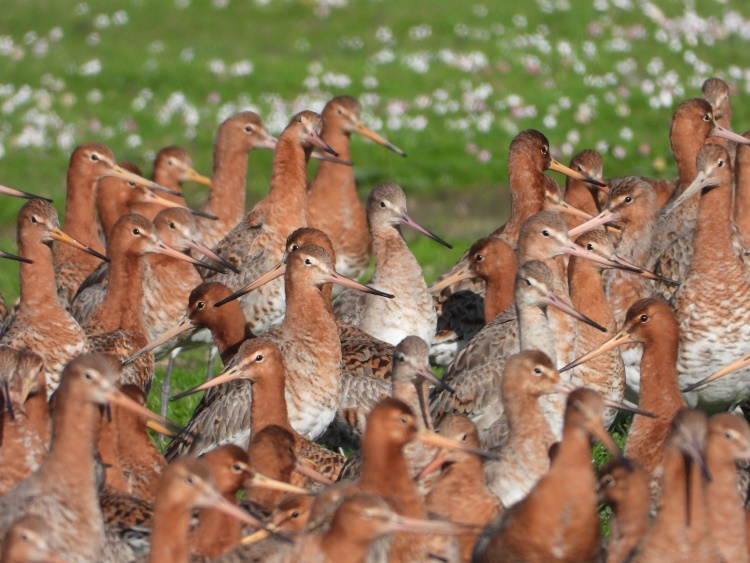
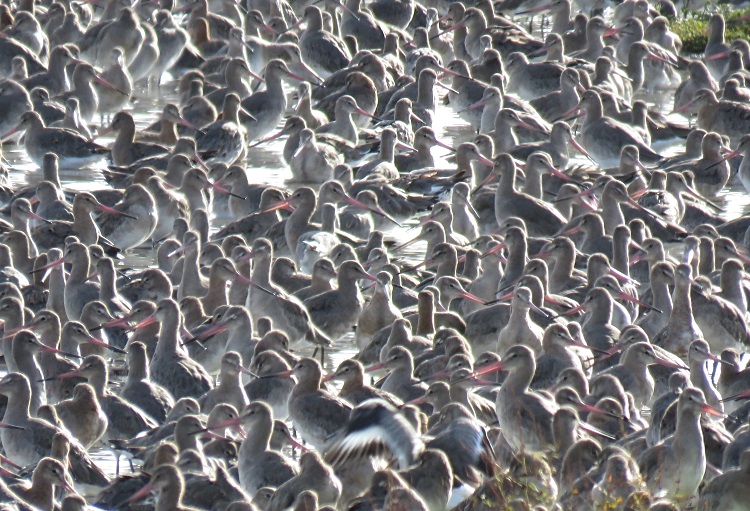
they had all moulted into winter plumage © Richard Smith
Knots
I have a distinct memory as a boy sitting in the
window of West Kirby Sailing Club watching Knots. I'd been out sailing
with my father in his old Solent Scow so the tide was on the ebb, and
I'm pretty certain it was August and the year was 1963. What I saw was
flock after flock after flock flying past heading from their West Kirby
roost towards Thurstaston. Thinking back now about what I saw I can
well imagine the total was well over 100,000.
My childhood observations may seem a bit vague, but
before systematic counts started in the early 1970s that was how it
was. The
year following my recollections the first Cheshire Bird Report was
produced and they certainly helped as at least records were written
down. In 1965 "The autumn peak in
the Dee Estuary probably occurred on
or about November 13th; ca. 100,000 at Red Rocks was considered a very
conservative estimate", and 1966 "The peak at Hilbre occurred on or
about October 30th when several
hundred thousands were
present. The difficulties of estimating
such a flock with any degree of accuracy are immense."
In the 1960s many of the Knots roosted on the Hilbre islands with Little Eye completely covered in them at high tide, and West Kirby Shore was also immensely important. But by the 1970s human disturbance had caused many Knots to desert Hilbre and West Kirby as their main roost site - sea anglers on Little Eye and exercising race horses on West Kirby Shore were major contributors to this disturbance. We still do get large numbers of Knots on the Dee Estuary, there have been several counts both at high and low tide between 40,000 and 50,000 since the turn of the century and what a great wildlife spectacle they make. I watched a flock of 30,000 over West Kirby shore a couple of winters ago, they were swirling around putting on a fantastic display - try to imagine what 10 times that would look like!!
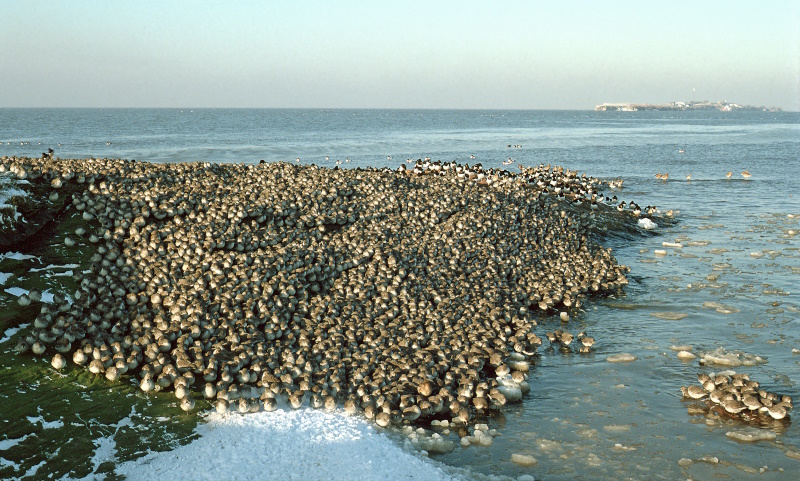
some knot were still using the island as a roost. I estimate around 10,000 in this photo and this is just one small corner of Little Eye.
© Guy Huntington
Terns
The 1960s and early 1970s saw some remarkable
reports of huge numbers of terns. The first report below, in 1965, was
from Hilbre and is the only one which mentions Sandwich Terns when
about 9,000 were counted on September 5th - despite there being a lot
less pairs breeding around the Irish Sea at that time then there are
now. The other reports don't distinguish between Arctic and Common
Terns but I suspect that the majority were probably Arctic Terns coming
down from Scotland, Scandinavia and, perhaps, even north-west Russia -
and at that time the River Mersey, and the channel going up towards
Formby, was probably being used as a staging post for them. We still do
get thousands of Arctic Terns in Liverpool Bay but these days they
mostly pass through Morecambe Bay on their way north in spring to
breed, with only
small numbers recorded on their return.
Hilbre
Bird Report 1965: On August
21st, 26th and
September 5th literally thousands of mixed terns were off the island,
certainly in such numbers that had not previously been recorded by the
Observatory. The observers found it impossible to specifically identify
and count each species so the estimates of numbers refer mainly to the
Common, Arctic, Little and Sandwich Terns. The estimates were as
follows:- August 21st and 26th - c5,000 and at least 1,000
respectively, Sandwich and "Comic" Terns predominated with a few
Little. September 5th - c10,000. Heavy movement to the north-east
during the two hours 05.30 - 7.30. Majority Sandwich, then Little, with
only a few "Comic".
Cheshire Bird Report 1969:
Vast numbers of 'Commic' terns were
present
in the mouth of the Mersey in late August and early September, whilst
these were largely on the Lancashire side of the river, big numbers
overflowed to the Cheshire side. From the Isle of Man boat on September
1 it was seen that dense clouds of terns stretched all the way from the
docks to the Formby Light, a distance of several miles. this
congregation must have numbered tens of thousands and at the same time
there were at least 1000 off Seacombe on the Cheshire side. At this
period numbers passing Hilbre were reported at 500 per day, 2000 on
August 16.
Cheshire Bird Report 1970: 5-6000 milling around feeding over the outflows from Birkenhead Docks....... the rate was 198 per minute (passing the bow of a ship) and the movement was watched in progress for an hour.
Cheshire Bird Report 1972: At Hilbre up to 600/day were passing... in the Mersey there was a count of 4200/hour over a period of three hours passing Seacombe in the second week of September.
Cheshire
Bird Report 1973:....
beginning of
September... on a rising tide when 12,000 were counted moving up river,
in the space of an hour, at New Ferry.
Leach's Petrels
Our Liverpool Bay coasts are rightly renowned for
being the best place to see Leach's Petrels in the country - but only
in the right weather conditions. Well, the weather was certainly right
in 1978 as described below:
Cheshire Bird Report 1978:
Persistent NW gales in September
resulted in
the largest ''wreck'' yet recorded in Cheshire.
A dawn to dusk watch was maintained
at Hilbre on most days throughout
the month. Birds first appeared on 11th with large numbers continuing
'through to 1st October. Counts from Hilbre as follows:
| Sept |
11th |
12 |
16th |
59 |
20th |
3 |
28th |
28 |
||||
| 12th |
20 |
17th |
663 |
25th |
4 |
29th |
19 |
|||||
| 14th |
50 |
18th |
34 |
26th |
116 |
30th |
139 |
|||||
| 15th |
328 |
19th |
14 |
27th |
959 |
Oct
|
1st |
4 |
On both 15th
and 27th the highest hourly counts were obtained about 3 hours after
the wind dropped and just before dusk. Counts refer to birds passing
west
and exclude small numbers passing east.
Along the north Wirral shore the
highest accurate count was of 505 moving west off Leasowe between 9am
and 3pm 17th and there were 400 or more there in 4 hours 30th.
ln the Mersey at least 2 to 20 per
day were counted off
Seacombe and New Brighton between 11th September and October 1st. Peaks
of 35 on 17th and 27th coincided with high counts at Leasowe and
Hilbre. Early
on 30th quite phenomenal numbers were present, with some hundreds off
Seacombe Ferry, and many had penetrated even further up the river. On
the ebbing tide an incredible number moved out of the river past large
numbers of observers stationed at New Brighton. No accurate counts have
been submitted, but a conservative estimate is of 800 petrels. The
lack of very large numbers off Hilbre on this date is interesting.
It has been suggested that upwards of
3,500 Leach's Petrels passed the
Wirral coast in September.
The following is also about that remarkable passage during September
1978. It's an
extract from J.D. Craggs'
classic "Hilbre" book (1982) and taken from an article included
in the book written by Ann and Tim Cleeves, Hilbre wardens at the time:
"On the 27th September the
sea-watching hide was manned for 12 1/2
hours. For the first 10 hours, petrels averaged about 60 an hour, but
one of the observers' resolve began to weaken when the hourly count hit
only 42 after a slight but steady decrease over the previous four
hours. However, with the observatory record standing at 663 birds in 8
hours, he was persuaded to stay. The next hour the count hit 83, and
the next 214. The reluctant observer realised that he would have to
resign himself to remaining in the hide until it was completely dark.
The count for the last hour was 130 birds and the total for the day was
959."
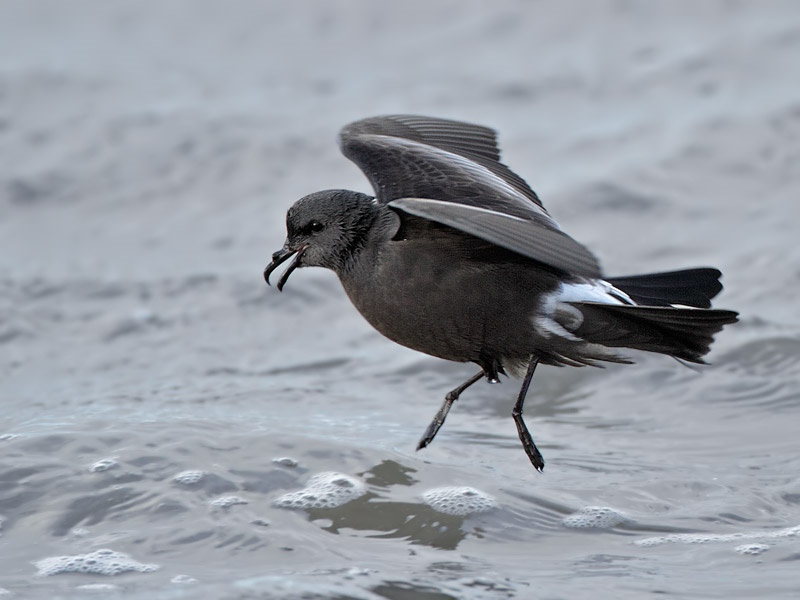
This Leach's Petrel was flying past Leasowe in September 2010 © Steve Round
Redwings
There was a massive Redwing migration through our area on October 19th 2022. It was estimated that at least 20,000 flew over Thurstaston that day and they were recorded in their thousands along the north Wirral coast, over Hilbre and down the estuary, as well as all over inland Wirral. But by far the biggest count, and the biggest single site count of Redwings ever made in the UK, was at Crosby Marine Park where an experienced migration watcher counted an amazing 122,600 all heading south - i.e. straight towards the north Wirral coast!
This big movement started in southern Norway and
Sweden on the evening of the 18th, the weather radar showed them flying
up in one huge mass before starting to fly out into the North Sea. Huge
numbers headed due south and ended up flying along the west coast of
Holland on the 19th. Others flew south-west and thousands were heard
crossing the County Durham coast at Jarrow overnight. By the morning
the large majority were recorded heading south over Lancashire, the
eastern half of Yorkshire and into Merseyside and Cheshire.
An article, 'A
Massive Redwing Migration', was published in my December
2022 Newsletter and shows maps of exactly where the birds were and
the routes they took.
I end with a quote from an observer who was at
Thurstaston in the afternoon of the 19th "I have just walked through
Dawpool NR, every berry tree
was alive with them. They where like locusts. Then a Sparrowhawk
spooked them all, what a spectacular sight."
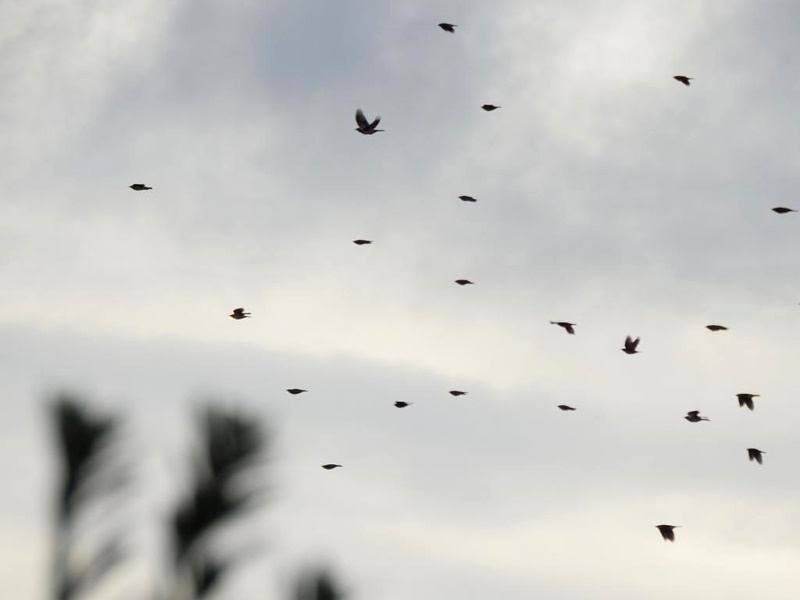
Richard Smith
Colour Ring Report
Oystercatcher
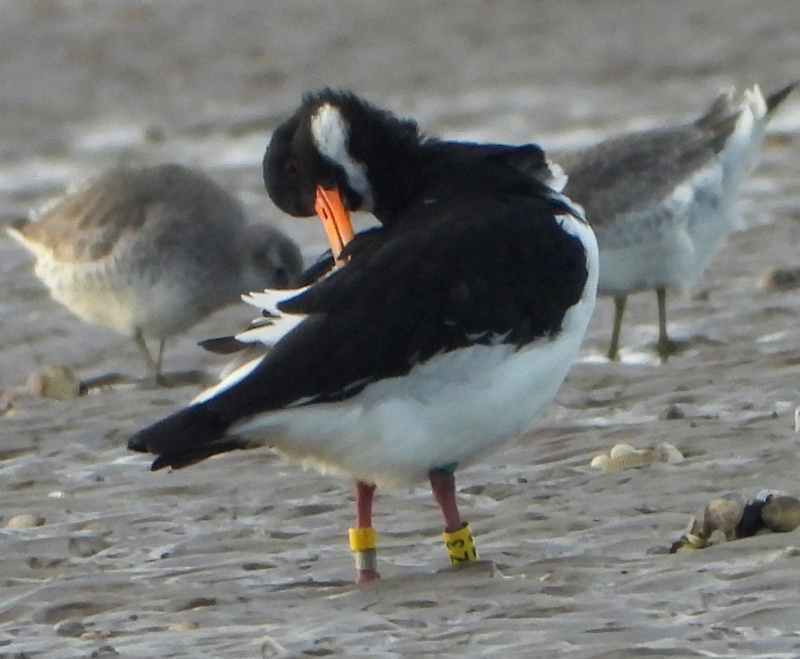
Y-G/Y(Z3)
Ringed in south Dublin Bay on January 25th 2020. It was a first winter
bird (hatched in 2019).
Recorded in Dublin Bay from February to September (including July and
August) 2020, and again in April, May and August 2021.
It was at west Sandwick, Yell, Shetland on July 19th 2022 - so perhaps
it's first year as a breeding bird.
Recorded on Thurstaston Shore November 24th 2023.
This bird was ringed as part of the Dublin Bay Birds
Project and I quote from their website (click here to go to the website):
"The Dublin Bay Birds Project is a comprehensive work programme of
year-round monthly low tide surveys; specific surveys and observations
targeted at particular species, including roosting gulls, breeding
terns and Brent Geese; and colour-ringing and radio-tagging of a
selection of key wader species, namely Oystercatcher, Bar-tailed
Godwit, Redshank and Curlew. The information we collect fills gaps in
our knowledge about the distribution and movements of birds within
Dublin Bay, as well as helping to consolidate what is already known."
Black-headed Gull
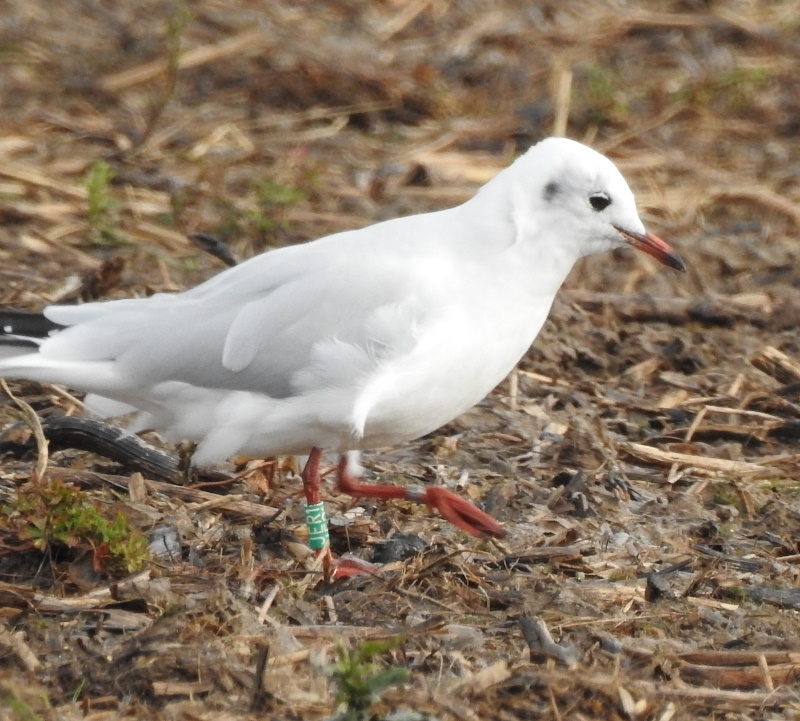
Green (JER1)
Ringed in Oslo on June 10th 2017, as a chick.
Recorded in Oslo in August 2019, May 2022 and May 2023.
It was feeding in a field just above the beach at Heswall on November
3rd 2023 - the first record away from Oslo.
Cormorant
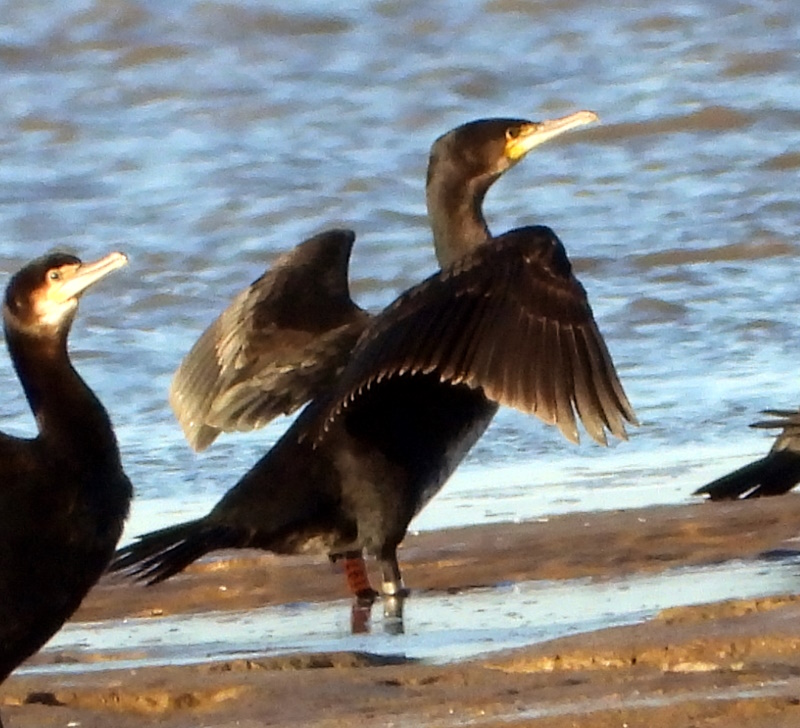
Orange (197)
Ringed at Hale Duck Decoy on May 19th 2023, as a chick.
Recorded at Hoylake on November 30th 2023.
Most Cormorants at Hoylake are seen standing on the
far edge of East Hoyle Bank. On a rising tide I looked at the legs of
about 30 in case one was ringed, and could just make out one with an
orange ring. It was far too distant to read the number through my
telescope but I took a photo of it on full zoom just in case. I was
pleasantly surprised when I got home and looked at the photo to see the
number 197 on the ring. Thankfully it had been a bright sunny day
otherwise I wouldn't have had any chance!
Little Egrets

Steve Hinde visits Heswall Shore and the adjacent fields most days. Colour-ringed Little Egrets are regular on the shore in summer and early autumn, but the rings are often difficult to read as they can be covered in mud and the birds distant, and usually he will see. at most, just one or two ringed birds on any single visit. So Steve was somewhat astonished when, of just eight Little Egrets feeding in one field below Dungeon Woods on November 7th, four had colour rings. A brief history of them below:
White (A) Green (B)
Ringed at Hale Duck Decoy in May 2023 as a chick. This was the first of
2023's ringed birds to be seen away from the nest when it arrived at
Thurstaston in July. It has been recorded two more times in the area
before November 7th.
White (V) Yellow (6)
Ringed at Penrhyn Castle, Bangor, at the end of June 2023 as a chick.
This was first seen just the day before, on November 6th, on the shore
at Heswall.
Blue (H4)
Ringed at Wheldrake Ings, Yorkshire, in July 2019. This bird has
returned to Heswall every year since, usually being recorded either in
August or September. Before November 7th it was last recorded at
Heswall in mid-August 2023.
White (Z) Yellow (C)
Ringed at Penrhyn Castle, Bangor, in June 2022 as a chick. Recorded at
Heswall in August 2022, and late June and August 2023.
A nice selection of Little Egrets showing how they arrive here from a wide variety of breeding sites. Note, it is likely that some Little Egrets hatched elsewhere are now breeding around the Dee Estuary .
Knots
We had 239 colour ring/flag records in December, almost all concentrated in a 10 day period mid-month when we had some good weather coinciding with a flock of up to 9,000 at Meols, a good number for that site. One of these Knots was fitted with orange flag MP, see below.
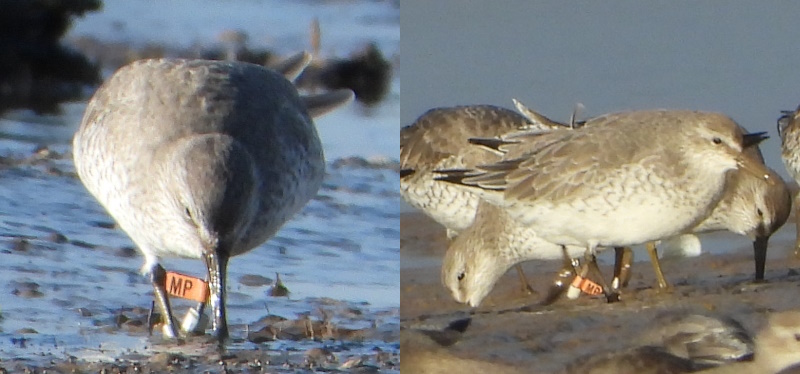
Regular readers of this newsletter will know about the Liverpool Bay Knot Project with several hundred Knots fitted with an inscribed orange flag, visible with a telescope, so we can study their movements, migration routes, longevity etc. The first catch was made on September 22nd 2017 at Altcar. I was totally unaware of this catch, and the following day I walked down from my house to look at the Black-tailed Godwits at the Caldy Wildfowl Collection. There were several thousand godwits present, a great sight, and at that time of year we often see a few Knot with them and I noticed there were at least 50 present that day. I knew the chances of seeing a colour ringed one was extremely remote but, nevertheless, had a quick look through them and with great excitement noticed one with an orange flag. Our small band of colour ring readers had been reading Knot rings/flags since 2006 and we'd never seen one with an orange flag before. The godwits were beginning to leave which made the Knots restless and they were running around making reading the letters on the flag almost impossible. But I eventually got one clear view - the letters were MP. A quick email to Jim Wilson (European Colour Ring Coordinator for waders) - "I've seen a Knot with a strange orange flag.........." - and the immediate reply told me all about the new project, about the catch the day before and the fact I was the first person to have seen one of the newly flagged Knots. Little did I know that these orange flagged Knots would become an obsession and that I would log an astonishing 2792 records up to the end of 2023!
So what has happened to Orange Flag MP between
September
2017 and December 2023? I saw it a further 12 times at Caldy up until
the end of November in 2017, it was recorded several times at
Thurtaston through that winter before returning to Caldy Wildfowl
Collection in April. It was a juvenile when it was caught so didn't
breed in 2018 and it was recorded at Walney (Morecambe Bay) in a small
non-breeding flock in June. It was spotted once at Crosby in
September that year before disappearing for over two years and then
turning
up again at Thurstaston at the end of November 2020. By 2022 it will
have been an adult breeding bird and it was recorded in Iceland in May
on it's way to Canada. Having only been recorded once in the Dee
Estuary area since April 2018 I was very pleased to see that it was
still alive when I spotted it at Meols on December 11th and 13th 2023.
This was the first winter record of MP since it's first winter in
2017/18.
The plethora of flags and rings used by the
different schemes can be confusing, but all is explained by Rose
Maciewicz and Peter Knight in their excellent Photographic Guide to Colour-ringed Red Knot.
Colour Rings were recorded by Richard Smith, Stephen
Hinde and Tony Ormond.
Richard Smith
December Bird News

There were quite a few Waxwings around through the
month ranging from Gronant in the west, Saughall Massie in the east and
Saughall in the south.
They were mostly brief views of small flocks but nine at Saughall
Massie on the 29th had increased to 17 the following day and gave
everyone a chance to see them and take some great photos. As well as
the photo above I've put a selection at the bottom of this section for
everyone to admire!
Mid-month saw some good weather and it was great to see up to 9,000 Knots on Meols Shore during that period, sometimes coming ridiculously close to the sea-wall. Further out to sea were a couple of Long-tailed Ducks, at least two Velvet Scoters and seven Red-throated Divers, the Great northern Diver stayed on West Kirby Marine Lake up to mid-month.
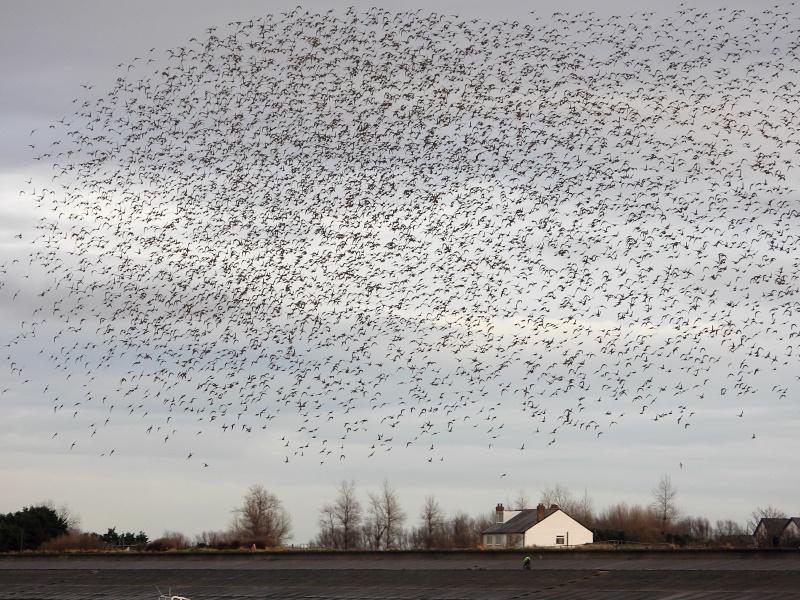
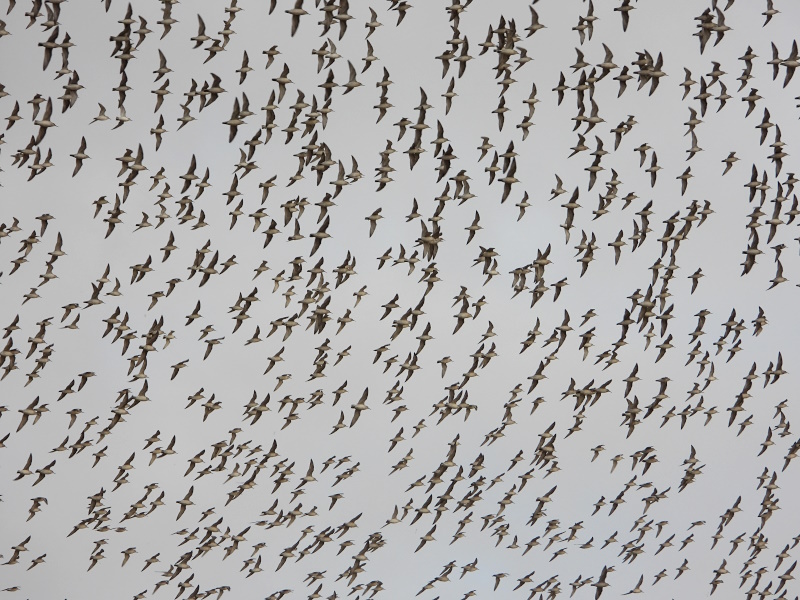
18 Purple Sandpipers was a good count on Hilbre on the 2nd and there were around 15 Cattle Egrets in a field near Shotwick Village on the 24th.
Five Green Sandpipers in one small pool north-east of Thornton Hough was an excellent record. Three Water Pipits were at Neston Old Quay on the 24th.
Four Hen Harriers at Parkgate was the highest count,
as was at least 12 Marsh Harriers at Neston Reed-bed. Given the
reported big influx of Short-eared Owls into the country in the autumn
it was disappointing to only have one record of a Short-eared Owl - on
Middle Eye.
All Waxwing photos below were taken in Saughall
Massie on 29th and 30th December.

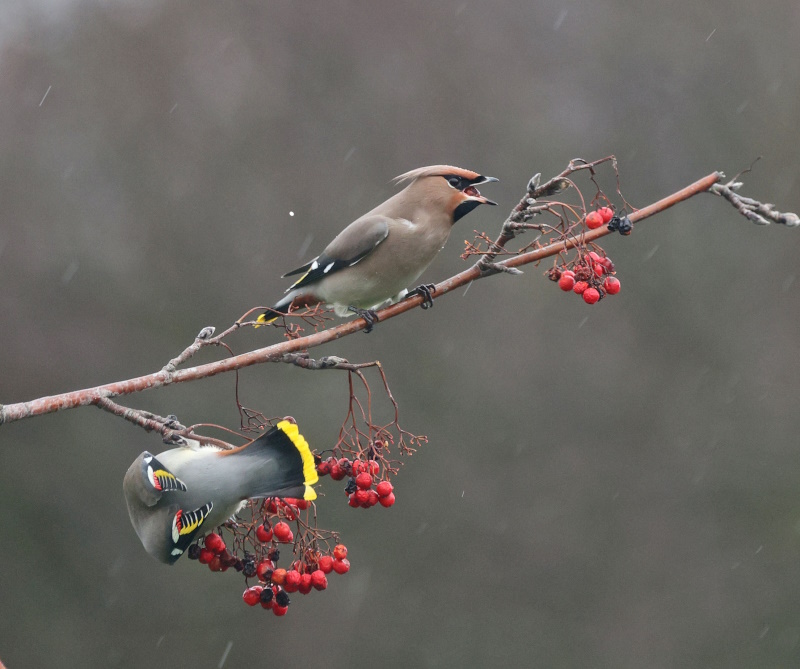
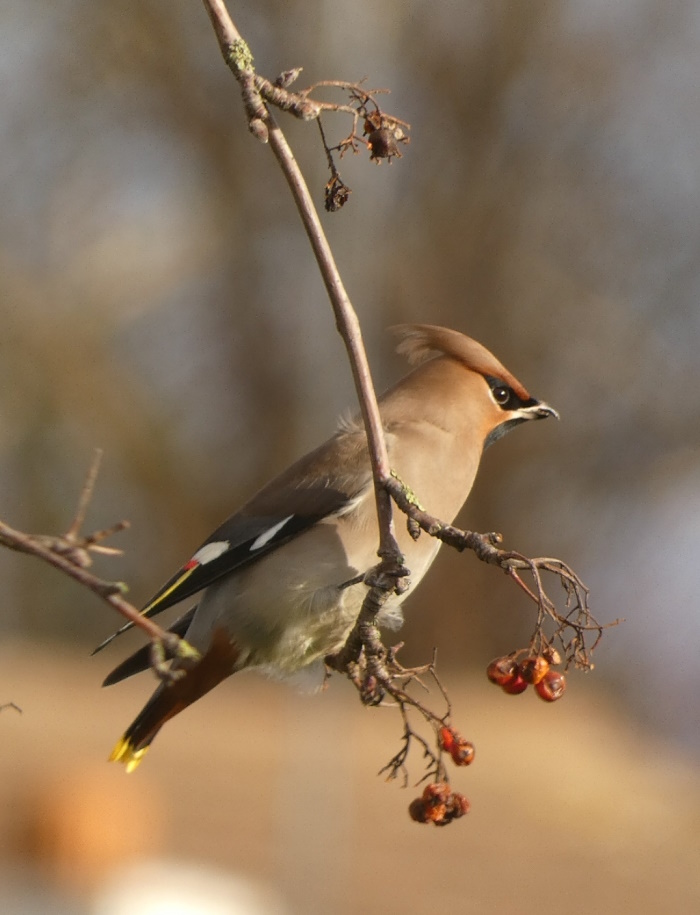
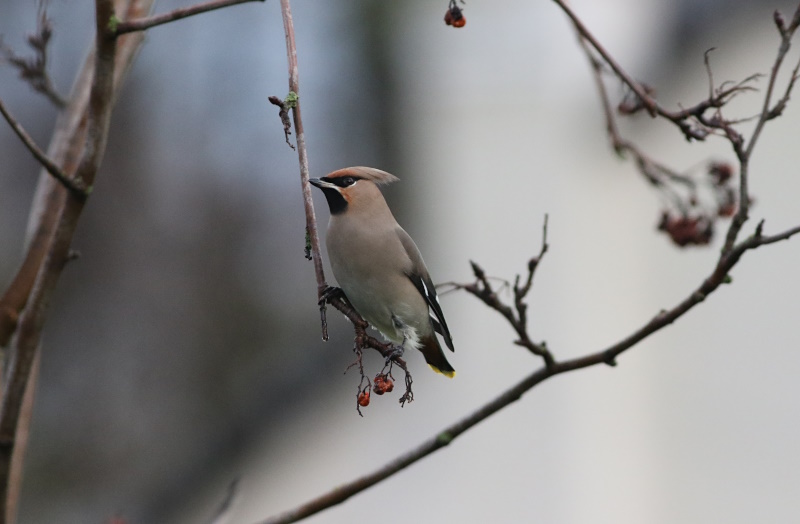
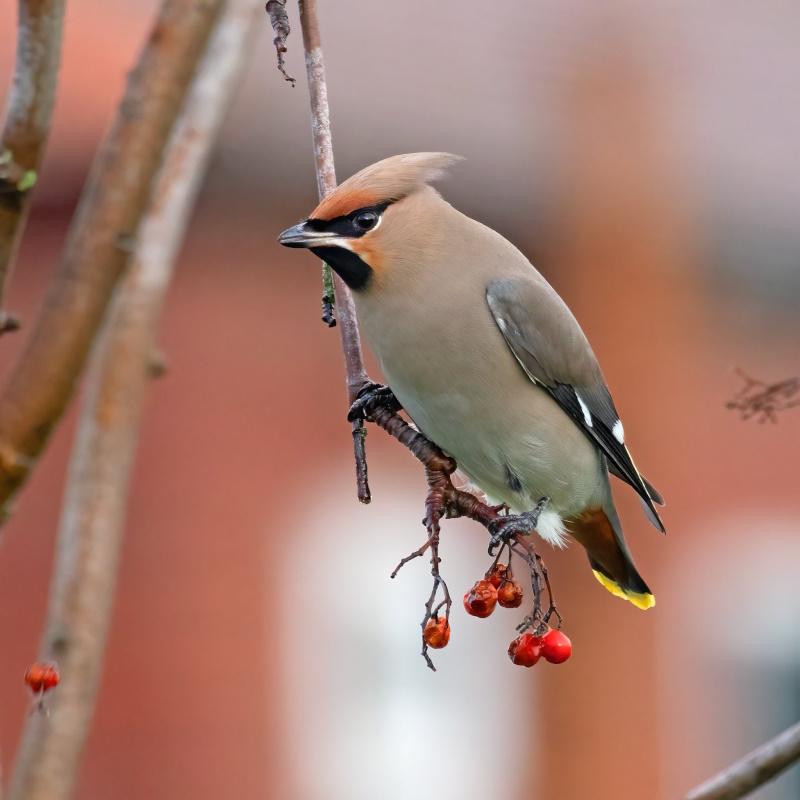
Ian Smith, Bill Wonderley, Chris Shaw, Ben Lane, Hugh Stewart, Martin Dohm, Jeff Hodgson, Richard Taylor, Sheila Saunders, Paul Carter, Paul Kenyon, Steve Liston, Ian Howarth, Roger Jacobs, the Dee Estuary Wardens and the Hilbre Bird Observatory for their sightings during December. All sightings are gratefully received.
What to expect in January
Hopefully we'll see a lot more Waxwing flocks, which could turn up anywhere with Rowan tree berries being favourite.
There are some good high tides mid-month, given some
nice strong westerly winds this should bring the sea over the marshes
giving spectacular views of thousands of Pink-footed Geese and all the
other thousands of birds which can include Brent Geese and Red-breasted
Mergansers just off the marsh edge. If the tide reaches the wall by
Heswall Golf Course we will get great views of Short-eared Owls which
often roost in that area, as well as both Marsh and Hen Harriers.
Given calm weather then a visit to Hoylake or Point
of Ayr could well be productive as January is often good for
spectacular wader roosts, we can expect 20,000 each of Knots and
Dunlins. Out to sea there can be thousands of Common Scoters and
hundreds of Great Crested Grebes, look out also for Velvet Scoters,
Goldeneyes, Long-tailed Ducks and Red-throated Divers, and last winter
we had a long staying Black Guillemot off north Wirral.
Forthcoming Events
January Highest Spring Tides (Liverpool)
Also see Tides page.
13th January, 12.19hrs (GMT), 9.7m.
14th January, 13.06hrs (GMT), 9.8m.
15th January, 13.53hrs (GMT), 9.7m.
Forthcoming Events
Also see events at https://events.rspb.org.uk/deeestuary